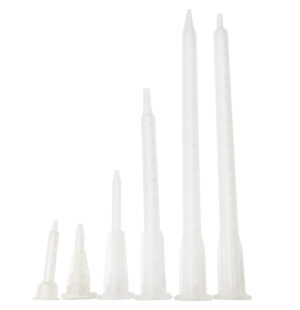
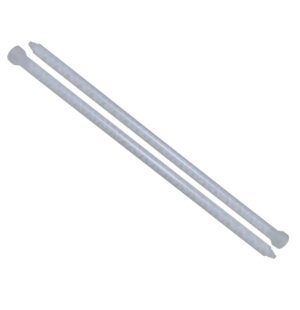
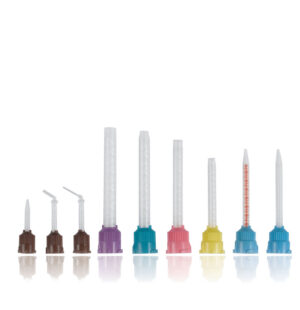

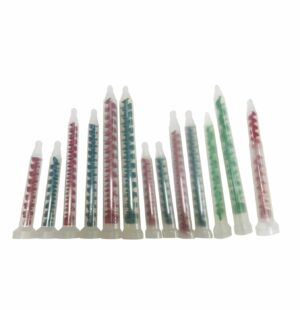
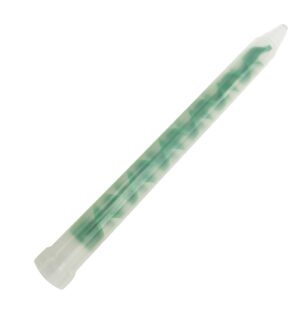
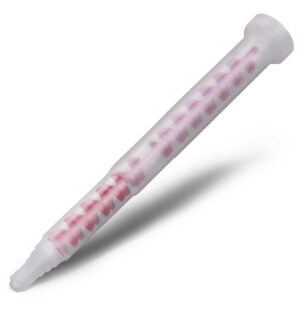

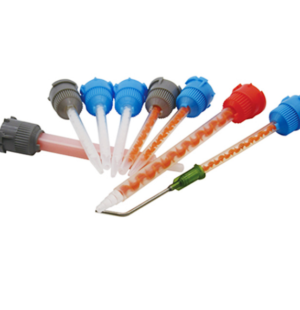
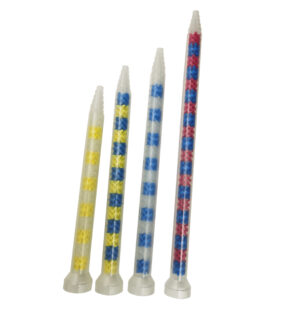
Here you can find static and dynamic mixing nozzles for industrial and various adhesives. We offer you a wide range of mixing nozzles in different sizes and materials – just right for your application. If there are special requirements, our team will help you find the solution you need. We have compiled the most important information for you below.
Mixing nozzles are mainly used for two-component adhesives, such as: Epoxy adhesives, Polyurethane adhesives, Acrylic adhesives.
According to the application scenario, we usually use different interface and internal structure of the mixing nozzle, some industries may also have requirements for the color of the mixing nozzle:
The Bayonet static mixing nozzle is a specialized device used for the efficient and thorough mixing of two-part adhesives, resins, and other viscous materials. Its unique design features a bayonet-style connection, which allows for easy attachment and detachment from the cartridge or container.
The nozzle incorporates multiple mixing elements, typically in the form of static elements such as helical or stepped blades. These elements create turbulence and intense intermixing as the materials flow through the nozzle, ensuring a homogeneous blend of the components.
The Bayonet static mixing nozzle offers several advantages, including consistent mixing ratios, reduced waste, and improved productivity. Its precise and reliable mixing capabilities make it ideal for various applications in industries such as construction, automotive, aerospace, and manufacturing.
The Bell Mouth static mixing nozzle is a specialized tool designed for effective and thorough mixing of two-component materials, such as adhesives, resins, and coatings. It is named after its unique bell-shaped entrance, which facilitates smooth and controlled material flow.
The nozzle features a series of internal mixing elements, typically in the form of fins or baffles, strategically positioned to create turbulence and promote thorough blending. As the materials pass through the nozzle, the mixing elements disrupt the flow, ensuring intimate contact between the components and resulting in a homogeneous mixture.
Bell Mouth static mixing nozzles offer several advantages, including consistent mixing ratios, reduced air entrapment, and improved dispersion of additives or fillers. They are widely used in industries such as construction, manufacturing, electronics, and automotive, where precise and uniform mixing is crucial for optimal performance.
Using a Bell Mouth static mixing nozzle is simple. Attach it to the cartridge or container containing the two-part materials, ensuring a secure connection. Apply pressure or dispense the materials, and they will flow through the nozzle, undergoing thorough mixing along the way. After use, the nozzle can be cleaned and reused if compatible with the materials or replaced with a new one.
The Square static mixing nozzle is a specialized device designed for the effective mixing of two-component materials, such as adhesives, resins, and sealants. Its distinct feature is its square-shaped design, which promotes efficient blending and uniform dispersion of the components.
The nozzle consists of multiple internal mixing elements, typically in the form of square-shaped blades or channels. These elements are strategically positioned to create turbulence and enhance the intermixing of the materials as they pass through the nozzle. The square shape of the mixing elements helps in achieving a thorough and homogeneous mixture.
Square static mixing nozzles offer several advantages, including precise mixing ratios, reduced waste, and improved bonding or coating quality. They are commonly used in industries such as construction, woodworking, automotive, and electronics, where accurate and consistent mixing is crucial for optimal performance.
Using a Square static mixing nozzle is straightforward. Attach it to the cartridge or container housing the two-component materials, ensuring a secure fit. Apply pressure or dispense the materials, and they will flow through the nozzle, undergoing efficient mixing as they pass through the square-shaped mixing elements. After use, the nozzle can be cleaned for reusability or replaced with a new one.
This mixing nozzle is specially designed for 50ml syringe guns and has a special interface for better sealing.
This mixing nozzle is available in 1:1 and 10:1 glue mixing ratios and can replace 08193, 08194, 08115, 3819, 38193 and DP100 mixing tubes.
The X-Grid static mixing nozzle is a specialized nozzle designed for use with plural-component spray equipment, typically used in the construction and coatings industries. It is specifically designed to mix and atomize two-component materials, such as epoxies, urethanes, and polyureas, at the point of application.
The X-Grid static mixing nozzle features a unique grid pattern that ensures thorough mixing of the two-component materials, resulting in a consistent and homogenous mixture. The nozzle is designed to work with a variety of different materials, including low and high viscosity coatings, and can be used with both airless and air-assisted spray equipment.
This dynamic mixing nozzle is one of our most popular products. It is made of polypropylene and is suitable for all low viscosity two-component adhesives.
This hybrid tube is specially designed for solar cells, and it is able to fully mix the solar cell adhesive. This product is also our best-selling product in Turkey.
Btektech offers 8 common sizes of dynamic mixing nozzles, each available in red or green inner color, and supports customization services.
Mixing nozzles are typically made of materials that are compatible with the substances being mixed and can withstand the required temperatures and pressures.Our mixing tubes are mainly made of the following four materials:
PP is a thermoplastic polymer known for its chemical resistance and durability. It is commonly used for mixing nozzles in applications involving adhesives, sealants, and various liquid formulations.
PE is another thermoplastic polymer that offers good chemical resistance and flexibility. Mixing nozzles made of PE are commonly used for dispensing and mixing adhesives, resins, and coatings.
Nylon is a versatile engineering plastic known for its strength and toughness. It is often used in mixing nozzles for applications involving high temperatures or abrasive materials.
PVC (Polyvinyl Chloride) is a widely used thermoplastic known for its chemical resistance and affordability. PVC mixing nozzles are commonly used in applications such as adhesives, construction, and plumbing.
Mixing nozzles are suitable for precise and controlled mixing in smaller quantities, while mixing paddles are more practical for larger volumes and offer more manual control over the mixing process. More details
In conclusion, the reusability of mixing nozzles depends on the specific type and design of the nozzle, as well as the materials being mixed. Here’s a concise summary:
Disposable Nozzles: Some mixing nozzles are designed as single-use or disposable. These nozzles are typically made of plastic and are intended to be discarded after a single use. They are convenient and eliminate the need for cleaning or maintenance.
Reusable Nozzles: Certain mixing nozzles are designed for reusability. These nozzles are often made of durable materials such as stainless steel or reusable plastics. They can be cleaned and reused multiple times, making them more cost-effective in the long run.
Whether a mixing nozzle is reusable or disposable, it is essential to consider the compatibility of the nozzle material with the substances being mixed. Some materials may cause degradation or contamination, rendering the nozzle unusable or ineffective. Additionally, proper cleaning and maintenance procedures should be followed to ensure optimal performance and longevity of reusable mixing nozzles. More details
The Epoxy Mixing Nozzles are used to continuously cut and reorganize two different liquids through blades in the tube, so as to completely and evenly mix the two different liquids into one.
Epoxy Mixing Nozzles are a very common type of product. These nozzles allow the different liquids to be mixed evenly in production, resulting in very good dispensing results. The mixing ratio can be precisely adjusted to suit the needs of the production, thus adapting to the production of different industrial products.
Btektech wholesale and retail Mixing Nozzles can be divided into two categories: Static Mixing Nozzles and Dynamic Mixing Nozzles.
Static mixing nozzles are widely used in two-component rubber cylinders and dispensing machines.
The standard specifications of dynamic mixing nozzles are divided into RM and RS, generally red core or green core. The product is used in electronic production, electrical manufacturing, civil construction, and automobile manufacturing.
According to tube style, it can be divided into a circular tube and square tube;
According to the interface style, the static mixing tube can be divided into the following: bayonet type, bayonet mount type, round mouth, and self threaded;
According to the shape of the rubber outlet, it can be divided into the stepped mouth, straight mouth, and conical mouth.
Epoxy mixing nozzles are essential tools in various industries, offering a convenient way to mix and dispense epoxy resins. However, there are times when questions arise about their use. In this blog, we’ll delve into the common queries and concerns surrounding epoxy mixing nozzles to help you make informed decisions about their application.
Epoxy mixing nozzles typically have a shelf life due to the hardening of the epoxy within the nozzle. Manufacturers recommend using them within a certain timeframe to ensure optimal performance. Using expired nozzles can lead to clogging and inefficient mixing, affecting the quality of your epoxy application.
While some users attempt to reuse epoxy mixing nozzles to save costs, it’s not recommended. Once epoxy cures inside the nozzle, it becomes challenging to clean thoroughly, leading to potential contamination of future epoxy mixes. It’s best to use a new nozzle for each epoxy application to ensure consistent results.
Epoxy mixing nozzles are designed to mix and dispense epoxy resins, which are typically at room temperature. Using them with hot adhesives can lead to several issues, including premature curing and damage to the mixing nozzle. It’s essential to use mixing nozzles compatible with the temperature of your adhesive for optimal performance.
Epoxy mixing nozzles are often designed for specific epoxy formulations, taking into account factors such as viscosity and curing time. Using a nozzle with an incompatible formulation can lead to improper mixing and compromised adhesive properties. Always check the compatibility of your epoxy formulation with the mixing nozzle before use.
Epoxy mixing nozzles can contribute to waste due to their disposable nature. However, some manufacturers offer eco-friendly options, such as nozzles made from recyclable materials or designs that minimize waste. Consider these options if sustainability is a concern for your application.
Discuss the advantages and disadvantages of using epoxy mixing nozzles compared to manual mixing or other automated mixing systems. Consider factors such as efficiency, cost-effectiveness, and ease of use.
Highlight the importance of proper ventilation, personal protective equipment (PPE), and handling procedures when working with epoxy resins and mixing nozzles. Provide tips for minimizing exposure and ensuring a safe working environment.
Explore how the use of epoxy mixing nozzles can lead to more consistent mixing ratios, reduced air bubbles, and improved adhesion properties in epoxy applications. Provide examples or case studies to support your claims.
Discuss how manufacturers offer a range of epoxy mixing nozzles designed for specific applications, such as high-temperature environments, underwater use, or fine-detail work. Explain how choosing the right nozzle can impact the success of your epoxy project.
Examine the environmental impact of using disposable epoxy mixing nozzles, including waste generation and disposal. Discuss strategies for reducing waste, such as recycling or reusing nozzles where possible.
Identify common errors or misconceptions that users may have when using epoxy mixing nozzles, such as improper storage, incorrect nozzle selection, or inadequate mixing techniques. Provide tips for avoiding these mistakes to achieve better results.
Discuss the compatibility of epoxy mixing nozzles with solvent-based epoxy formulations, considering factors such as chemical compatibility and mixing efficiency. Provide guidance on selecting the right nozzle for solvent-based epoxy applications.
Explore how the design and mixing action of epoxy mixing nozzles can affect the curing time of epoxy resins. Discuss how proper mixing can ensure uniform curing and avoid issues such as under-curing or over-curing.
Explain how manufacturers offer epoxy mixing nozzles designed for specific viscosity ranges of epoxy resins. Discuss how selecting the right nozzle for the viscosity of your epoxy resin can improve mixing efficiency and application quality.
Outline the important features of a high-quality epoxy mixing nozzle, such as robust construction, consistent mixing performance, and compatibility with various epoxy formulations. Provide tips for selecting a nozzle that meets your specific application requirements.
Discuss how proper mixing and dispensing of epoxy resins using mixing nozzles can contribute to achieving strong and durable epoxy joints. Highlight the importance of uniform mixing for optimal bond strength.
Explore how epoxy mixing nozzles can be used for mixing epoxy resins with color pigments or dyes to create custom-colored epoxy mixes. Discuss tips and best practices for achieving consistent and uniform coloration.
Compare the benefits of using disposable epoxy mixing nozzles, such as convenience and reduced risk of cross-contamination, with reusable nozzles, which may offer cost savings and environmental benefits. Discuss factors to consider when choosing between disposable and reusable options.
Explain how the proper mixing and dispensing of epoxy resins using mixing nozzles can improve the workability of epoxy, making it easier to apply and manipulate. Discuss the role of nozzle design in achieving desired workability characteristics.
Investigate how manufacturers offer epoxy mixing nozzles designed for dispersing additives, such as fillers or thickeners, into epoxy resins. Discuss the benefits of using specialized nozzles for additive dispersion in epoxy applications.
Btektech have a long history of R&D and design of nozzles and have a wealth of experience in their application and manufacture, and can provide customers with professional advice and guidance on product selection. Btektech products are of high quality, delivered in a timely manner and can be supplied with packaging services. We welcome enquire from interested manufacturers at any time.
Btektech can carry out customized production of Epoxy Mixing Nozzles. This includes static mixing nozzles and dynamic mixing nozzles for use in industrial manufacturing. The shape of the nozzle, the shape of the tube body and the shape of the glue outlet can be designed and custom-produced to suit the customer’s production needs.
CONTACT